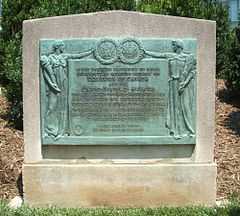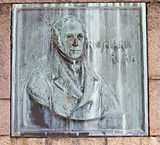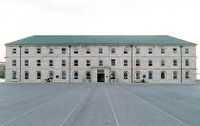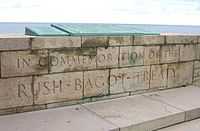Rush–Bagot Treaty

The Rush–Bagot Treaty or "Rush-Bagot Disarmament", was a treaty between the United States and Britain limiting naval armaments on the Great Lakes and Lake Champlain, following the War of 1812. It was ratified by the United States Senate on April 16, 1818.,[1] and has been confirmed by Canada, following Confederation in 1867. The treaty provided for a large demilitarization of lakes along the international boundary, where many British naval arrangements and forts remained. The treaty stipulated that the United States and British North America could each maintain one military vessel (no more than 100 tons burden) as well as one cannon (no more than eighteen pounds) on Lake Ontario and Lake Champlain. The remaining Great Lakes permitted the United States and British North America to keep two military vessels "of like burden" on the waters armed with "like force". The treaty, and the separate Treaty of 1818, laid the basis for a demilitarized boundary between the U.S. and British North America.[2]
History


The origins of the Rush–Bagot Treaty can be traced to a correspondence of letters between Acting United States Secretary of State Richard Rush and the British Minister to Washington Sir Charles Bagot, which were exchanged and signed on April 27 and 28, 1817. After the terms of the notes were agreed upon by Rush and Bagot, the Rush-Bagot Agreement was unofficially recognized by both countries. On April 6, 1818, it was submitted to the United States Senate and formally ratified on April 16, 1818. The treaty eventually led to the Treaty of Washington of 1871, which completed disarmament. The United States and Canada agreed in 1946, through an exchange of diplomatic notes, that the stationing of naval vessels for training purposes was permissible provided each government was fully notified in advance. In 2004, the U.S. Coast Guard decided to arm 11 of its small cutters stationed on Lake Erie and Lake Huron with M240 7.62 mm machine guns. The American decision was based on a climbing number of smuggling operations as well as the increased threat of terrorist activity after the September 11, 2001, attacks. The Canadian government decided that the armament did not violate the treaty, as the guns were to be used for law enforcement rather than military activities. Canada reserved the right to arm its vessels (Canadian Coast Guard) with similar weapons.[3]
Military Installations

The Stone Frigate, located at the Royal Military College in Kingston, Ontario, was constructed during 1820 to store part of the dismantled British fleet from the War of 1812, which had been dismantled pursuant to the Rush-Bagot Treaty of 1818.[4]
There are still military facilities near or next to the Great Lakes:
- Canadian
- CFB Kingston, Kingston, Ontario
- Royal Military College - Kingston, Ontario
- CFB Trenton, Trenton, Ontario
- CFD Mountain View - Prince Edward County, Ontario
- HMCS York Canadian Maritime Command Reserve base - Toronto, Ontario
- 4th Canadian Division HQ - Toronto, Ontario
- Denison Armoury/ASU Toronto - Toronto, Ontario - site of former CFB Downsview airbase
- Canadian Forces College - Toronto, Ontario
- Dalton Armoury, Toronto
- Oakville Armoury, Oakville, Ontario
- Col J.R. Barber Armoury, Georgetown, Ontario
- Moss Park Armoury, Toronto
- CFB Borden, Borden, Ontario
- Fort York Armoury, Toronto
- Four Mile Point Live Firing Range - Niagara-on-the-Lake, Ontario
- ASU London, London, Ontario
- LFCATC Meaford, Meaford, Ontario
- American
- Niagara Falls Air Reserve Station - Niagara Falls, New York
- Camp Perry - Port Clinton, Ohio
- Selfridge Air National Guard Base - Harrison Township, Michigan
- Duluth Air National Guard Base - Duluth, Minnesota
- Finland Air Force Station - Finland, Minnesota
- Minneapolis Armory - Minneapolis, Minnesota
- Empire Air Force Station - Empire, Michigan
- Grand Marais Air Force Station - Grand Marais, Michigan
- Port Austin Air Force Station, Port Austin, Michigan
- Sault Sainte Marie Air Force Station - Sault Sainte Marie, Michigan
- Wisconsin Air National Guard - General Mitchell International Airport - Milwaukee
Outcome
The border between the US and British North America was demilitarized, including the Great Lakes and Lake Champlain. The US and Britain agreed to joint control over the Oregon Territory. The Rush Bagot Agreement created the world's longest east–west boundary—5,527 miles. The US-Canadian border is the largest demilitarized border in the world.[5] The treaty may have been one reason the battleship Illinois was constructed as a replica.
Plaques

An Ontario Heritage Trust plaque in Kingston, Ontario recognizes the Rush-Bagot Agreement (44°13′48″N 76°27′59″W / 44.229894°N 76.466292°W). A plaque also stands at the former site of the British Legation in Washington, D.C. (38°54′13.7″N 77°3′8.4″W / 38.903806°N 77.052333°W) where the agreement was negotiated. A monument stands on the grounds of Old Fort Niagara as well (43°15′48″N 79°03′49″W / 43.263347°N 79.063719°W), featuring reliefs of both Rush and Bagot, as well as the words of the treaty.[6]
Notes
- ↑ Norton, Mary Beth (2001). A People and a Nation. Boston: Houghton Mifflin Company. p. 246. ISBN 0-618-00550-1.
- ↑ "Rush-Bagot Convention Facts, information, pictures | Encyclopedia.com articles about Rush-Bagot Convention". Encyclopedia.com. 2005-01-08. Retrieved 2011-05-05.
- ↑ http://www.journaltimes.com/articles/2006/03/11/local/iq_3947488.txt
- ↑ Gilbert Collins Guidebook to the Historic Sites of the War of 1812 p. 201
- ↑ http://www.aandc.org/research/rush-bagot_agreement.html
- ↑ "Rush-Bagot Agreement". Heritagefdn.on.ca. Retrieved 2011-05-05.
External links
| Wikisource has original text related to this article: |
- http://www.encyclopedia.com/topic/Rush-Bagot_Convention.aspx
- Avalon Project - Text of Agreement
- Rush-Bagot Agreement
- Nuclear Weapons, the Great Lakes and Lake Champlain HNN article about Rush-Bagot and its impact on the nuclear arms race
- Ontario Heritage Trust The Rush-Bagot Agreement, Under the terms of this 1817 arms-limitation agreement, the United States and Great Britain agreed to dismantle most of their armed vessels on the Great Lakes and Lake Champlain and to construct no new warships. The agreement, technically, is still in force.
